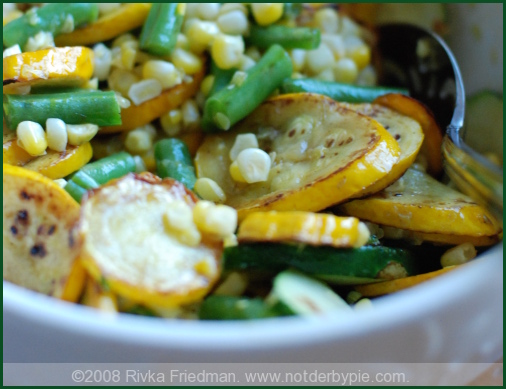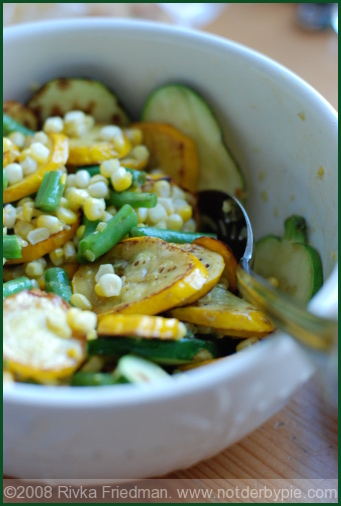 So sorry that posts have been so few and far between (and so short) lately. I'm doing my best to offer some great summer suggestions between work and work -- bear with me; just two more weeks of this insanity, and I'll be back on track.
So sorry that posts have been so few and far between (and so short) lately. I'm doing my best to offer some great summer suggestions between work and work -- bear with me; just two more weeks of this insanity, and I'll be back on track.
Meanwhile, hopefully you're taking advantage of the last of summer's produce more than I am. If you find yourself swimming in corn, this smoky number is a great variation on the corn salad theme. It combines raw corn that's charred in a smoking castiron pan, poblanos that are cooked over an open flame to remove the skins and intensify their flavor, a bit of red onion, and of course, some of those delightfully plump and round cherry tomatoes that are so good this time of year. The method is so simple it's a joke: just char everything in the castiron pan all together, and add the tomatoes just before serving. It's just the way to take advantage of summer's abundance. Have a plate in my honor, and once I crawl out from under this rock, I'll be back in the kitchen in no time.
Smoky Corn Salad
3 ears of corn, husks and fibers removed 1 cup cherry tomatoes, halved 1/4 of a red onion, diced 2 poblano peppers 1/2 a jalapeno, diced, optional 1/4 tsp. smoked spanish paprika olive oil salt pepper 1 lime
Roast poblanos over an open flame, turning to blister skin on all sides. When fully blistered, turn off heat and transfer peppers to a paper bag or roll inside tinfoil. let steam for 5 minutes, then run under water to remove skins. Chop roughly and set aside.
Heat castiron or heavy stainless steel pan over high heat. Remove corn from cob, and combine with chopped onions and jalapeno, if using. Add 1 tablespoon olive oil to pan and immediately add corn mixture. Toss to coat, then let sit for a 30 seconds at a time just to develop a real char on the kernels. Add smoked paprika, and add salt to taste. Keep tossing and charring, tossing and charring, until there are enough brown spots to give some serious smoky flavor. Remove from heat, add tomatoes, and toss to combine. Transfer to a plate, and squeeze 1 fresh lime overtop. Serve warm or at room temperature.
 Basil is aplenty at DC's farmers' markets. This week, my favorite farmer was selling massive bags of the stuff for just $3.99. I probably came home with a good 2 pounds of basil -- hard to imagine considering how light it is. There was only one thing to do: make pesto.
Basil is aplenty at DC's farmers' markets. This week, my favorite farmer was selling massive bags of the stuff for just $3.99. I probably came home with a good 2 pounds of basil -- hard to imagine considering how light it is. There was only one thing to do: make pesto. From a vege-mostly-tarian’s perspective, spring and summer are the seasons to beat. Fresh fruit and vegetables are available in abundance, and the variety, especially in summer, is simply unmatched. I make at least one salad a day; using anything from the usual lettuce and Israeli cucumbers to radishes to carrots to tomatoes and nectarines, mushrooms and garlic scapes and beets and even raw kale (my newest addition), I rarely repeat ingredients two days in a row.
From a vege-mostly-tarian’s perspective, spring and summer are the seasons to beat. Fresh fruit and vegetables are available in abundance, and the variety, especially in summer, is simply unmatched. I make at least one salad a day; using anything from the usual lettuce and Israeli cucumbers to radishes to carrots to tomatoes and nectarines, mushrooms and garlic scapes and beets and even raw kale (my newest addition), I rarely repeat ingredients two days in a row. 
 Round next of my weekday lunch series, where I post about dishes that'll put PB&J to shame.
Round next of my weekday lunch series, where I post about dishes that'll put PB&J to shame.